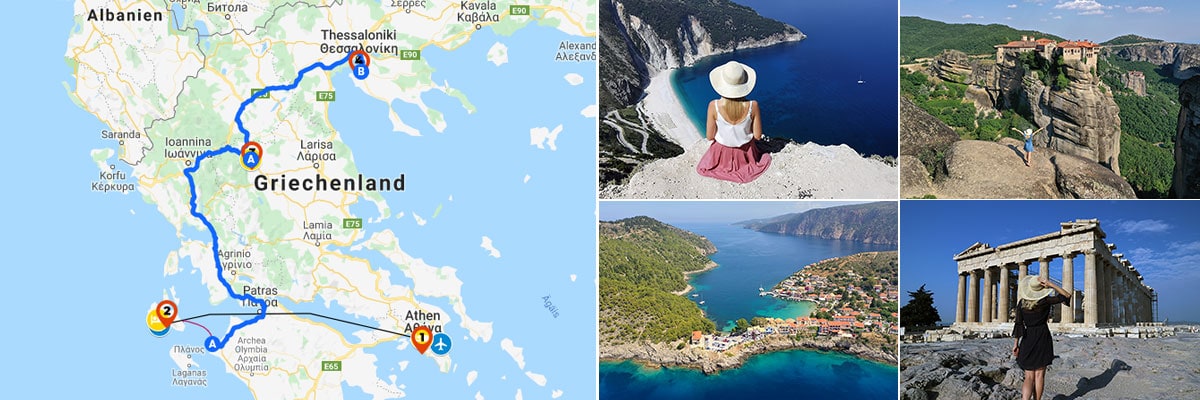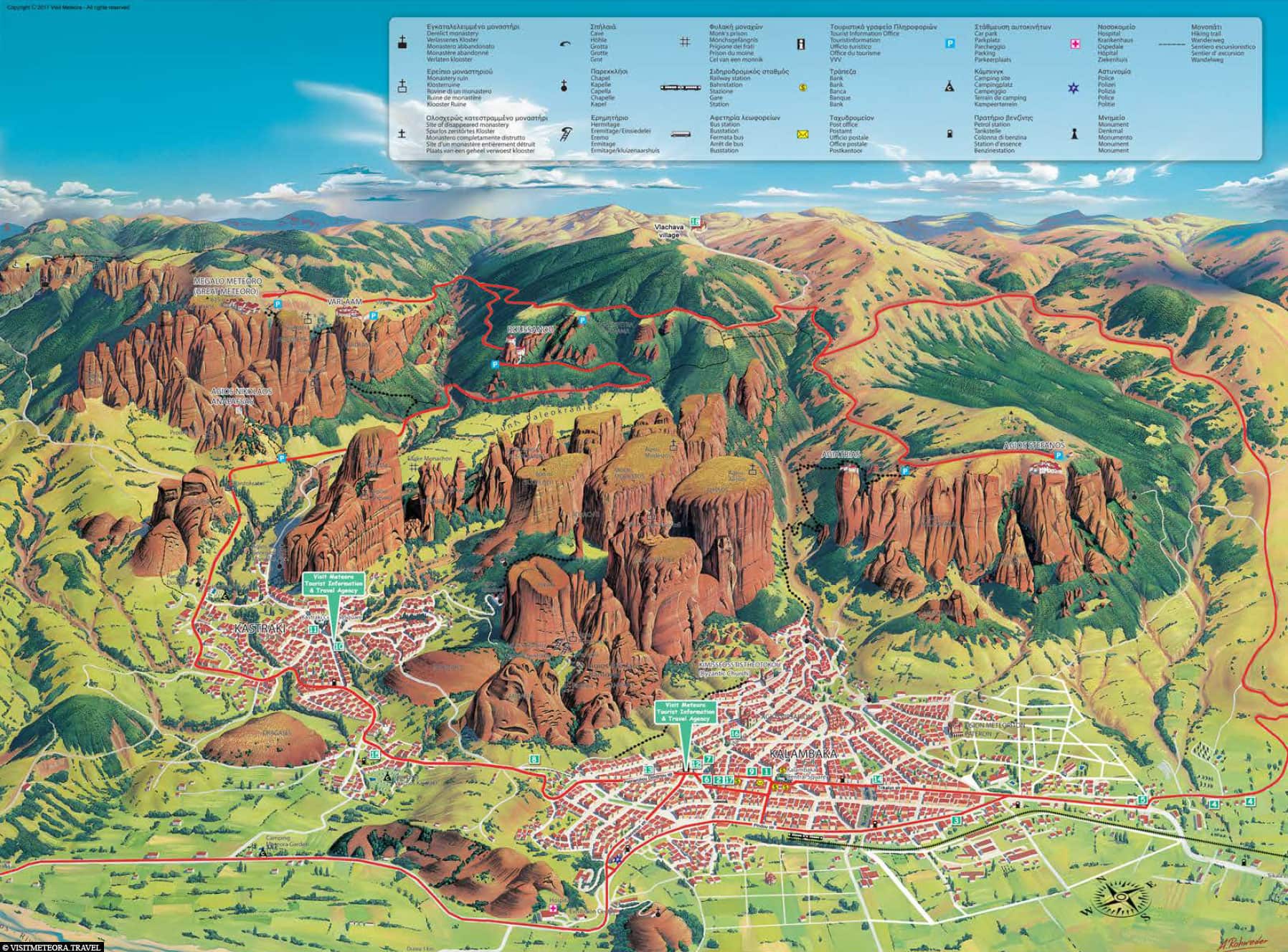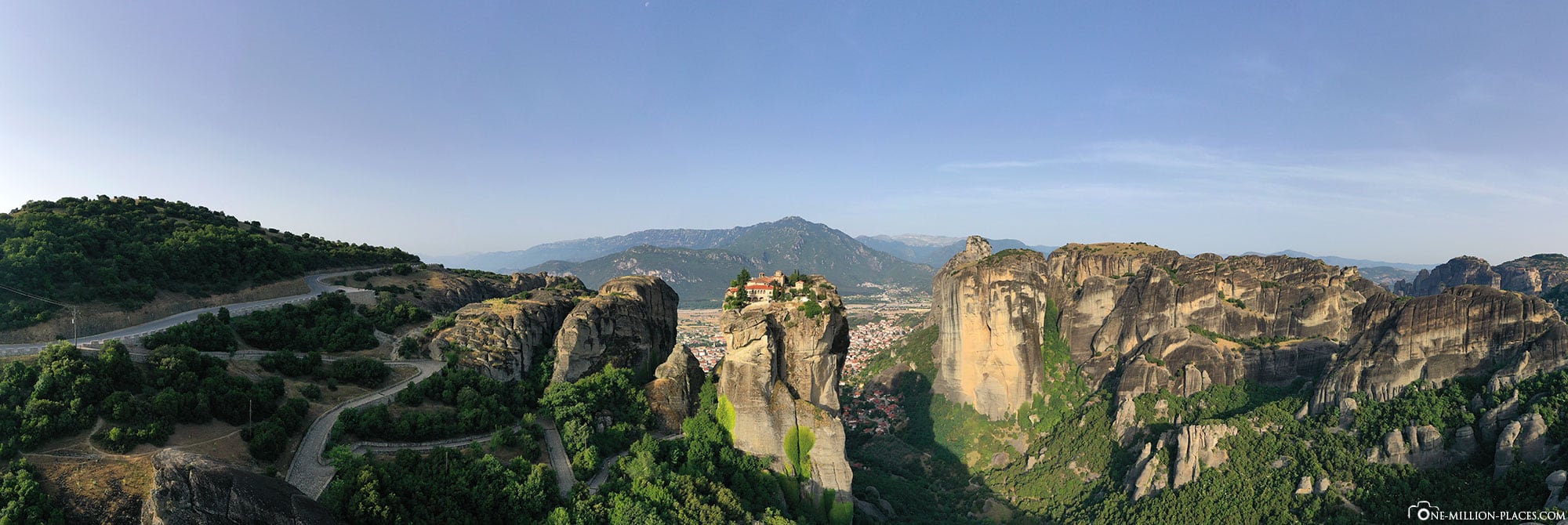M E T E O R A – When we first heard the word, it immediately triggered something magical and mystical. The monasteries of Meteora have long been on our list of destinations that we really wanted to see. We were all the more pleased that this year, as part of our trip to Greece, it was successful to visit this UNESCO World Heritage Site 🙂

Table of contents
Things to know about Meteora
The name Meteora derives from meteorizo, which means “lift up” or “floating freely in space”. This refers to the location of the monasteries built on high, vertical sandstone rocks. Especially in foggy weather, it sometimes seems as if they are hovering over the surrounding area.
History
Above the city of Kalambaka, sometimes bizarrely shaped sandstone rocks protrude into the sky, which were formed long ago by prehistoric rivers. Erosions, earthquakes, strong winds and rains have led to today’s form, which consists of several rock pinnacle, hills and caves.
On these rocks are the Meteora monasteries. The monastic life in Meteora began around the 11th century with the arrival of the first monks, who retreated into niches and caves of the rocks. Over the years, these herdders developed into an organized community modelled on the sacred mount of Athos, and the monastery of Dospiani was built. This makes it the first monastery to be founded in Meteora. Today the monastery is no longer preserved; on the site, a chapel was built in the 13th century, which is still in use today.
In 1334 the monk Athanasios came to the area, who had fled from Athos. In 1344, together with other monks, he founded the first monastic community in the monastery of Great Meteoro. Other monks followed him from different corners of Greece and built more monasteries in the course of the 14th century.
In total there were once 24 monasteries here. Today only 6 monasteries are inhabited by monks or nuns. The remaining monasteries are either destroyed or very difficult to reach. Since 1988, the monasteries of Meteora have been a UNESCO World Heritage Site.
Opening hours, parking & admission
Even if we were a little surprised, the entrance to Meteorais completely free. So you can look at all the monasteries – at least from the outside – completely free of charge and enjoy the insane views. That’s really great! Only if you want to visit the six monasteries Great Meteoro, Varlaam, Rousénou, Holy Trinity, St. Stefan and Agios Nikalaos Anapavs’s also indoors,this costs 3 EUR per monastery per person.
In the following overview you can see the different opening hours of the monasteries. Each of the monasteries has a rest day on a different day of the week, so that only on weekends all monasteries are open (summer 01.04. – 31.10. / winter 01.11. -31.02.)
Monastery of Agios Nikolaos Anapavsas – Summer: 9 a.m. to 4 p.m. / Winter: 9 a.m. to 4 p.m. / Closed: Fridays
Rousanou Monastery – Summer: 9 a.m. to 5 p.m. / Winter: 9 a.m. to 2 p.m. / Closed: Wednesdays
Holy Trinity Monastery – Summer: 9 a.m. to 5 p.m. / Winter: 10 a.m. to 4 p.m. / Closed: Thursdays
Monastery of St. Stephen – Summer: 9 a.m. to 1:20 p.m. & 3:30 p.m. to 5:30 p.m. / Winter: 9.30 a.m. to 1 p.m. & 3 p.m. to 5 p.m. / Closed: Mondays
Varlaam Monastery – Summer: 9 a.m. to 4 p.m. / Winter: 9 a.m. to 3 p.m. / Closed: Fridays / Closed: Thursdays (Winter)
Great Meteoro Monastery – Summer: 9 a.m. to 3 p.m. / Winter: 9 a.m. to 2 p.m. / Closed: Tuesdays / Closed: Wednesdays, Thursdays (winter)
Parking is free anywhere. However, the parking spaces in front of the monasteries are occupied very quickly, especially in the high season, so that you can only park along the street.
Explore tours & on your own
The area of Meteora is relatively compact and centrally located. From the town of Kalambaka you can drive to the first monastery of Agios Nikolaos Anapavsas in just 5 minutes. The other monasteries are also close together. Therefore, it is a good place to explore Meteora on your own with a rental car. The roads are all very well developed and you can stop again and again along the road to enjoy the view of the mountains and monasteries.
Of course you can also hike, but through the mountains these are already sometimes really steep routes. A circular route is indicated in Google Maps with about 20 kilometers.
If you want to learn more about the history of Meteora, a guided tour is a good place to go. Either in a group or as a private tour. We had a Sunset Tour of Visit Meteoraon our first day at 4 pm, which are one of the biggest tour operators in the city. The next day we had a private tour with Christos and his wife from Meteora Photo Tour. Find out more below.
Tips
To get the best stay in Meteora, we have some important tips for you:
(1) Be on the move individually – The best thing is to be able to visit the monasteries flexibly and individually. Therefore, you can rent a car or take a hike from Kalambaka or Kastraki.
(2) Getting up early is worth it – be early at the monasteries to be there in front of the tourist crowds. Most coaches arrive on time at 9 a.m. to let the first tourists out in front of the monasteries. We got up at 6 o’clock in the morning to take photos and drone shots in peace – that was worth gold!
(3) Meteora in the Sunset Light – Watch a sunset from the two Sunset Spots. To see the sky slowly discolor and the landscape and monasteries to be shrouded in a beautiful light is simply breathtaking.
(4) The right perspective – Take zoom lenses with you to photograph the monasteries from all perspectives and distances.
(5) Drink enough – A few litres of water should not be missing, because especially in summer it can get really hot in Meteora.
(6) Dress Code – Observe the dress code for visiting the monasteries: men should not wear shorts. Shoulder-free tops are not allowed in women. If women wear miniskirts or trousers, they are asked to tie an apron or a cloth at the monastery entrance. These can be borrowed free of charge at the respective entrances.
A map of Meteora
The following map gives a good overview of Meteora, Kalambaka and Kastraki.
We have created an interactive map with all 6 accessible monasteries and the most beautiful photo spots in Google Maps.
The Meteora Monasteries
In total there were once 24 individual monasteries in Meteora! Today, only six of them are inhabited. The remaining eighteen monasteries are either difficult to reach or have been abandoned due to the increased risk of collapse. In the following we show you the 6 still inhabited monasteries of Meteora:
The monastery of Agios Nikolaos Anapavsas
The monastic monastery of Agios Nikolaos Anapavsas, founded at the end of the 14th century, is the first monastery to be reached on the road from Kastraki to Meteora. It is perched on an 80-metre-high rock pin and was therefore also limited in size under construction. Therefore, the monastery had to be built over several floors.
Rousanou Monastery
The still inhabited nunnery Rousanou was probably founded in the 14th century as a monastic monastery. Due to many raids and looting, Rousanou was abandoned in 1940, but was later rebuilt and restored.
The Monastery of Holy Trinity (Agua Triada)
The monastery of Holy Trinity became known worldwide because it was used to shoot various scenes from the 1981 James Bond film “In Deadly Mission”. The monastery complex was built in the 15th century and was for a long time only accessible by winches and rope ladders. Only since 1925 there is a staircase with about 150 steps, through which one can reach the monastery.
The Monastery of St. Stephen (Agios Stéphanos)
Founded in 1312, the monastery of St. Stephen is the last monastery on Meteora Street and the easiest to access. Here you don’t have to climb steep stairs, but you get to the monastery via a small bridge. In the 19th century there were still more than 30 monks living in the monastery of St. Stephen. In 1960 it was almost deserted and was converted into a nunnery a year later.
As part of our Sunset Tour we visited the monastery and were able to gain a little insight into the interior of the monastery. On the monastery grounds there are two cathedrals: the old chapel from the 16th century, which was badly damaged during the Second World War and the resulting Greek Civil War, and the main cathedral from the 18th century.
Varlaam Monastery (Agion Panton)
Varlaam Monastery is the second largest monastery and is located directly opposite the Great Meteoro Monastery. It was founded in the middle of the 14th century as a hermitage; in 1518 the construction of the monastery began. The most beautiful view of the monastery is from an offshore rocky plateau, which is located directly between the monasteries of Great Meteoro and Varlaam.
The Monastery of Great Meteoro (Megélo Metéoro)
The Great Meteoro Monastery is the largest and oldest of all, with a complex of 60,000 m2. It is located at an altitude of 613 meters above sea level and is still inhabited by monks. On our Sunset Tour we were told that in fact only 4 or 5 monks live in the large monastery. This monastery, like many others, was initially only accessible with rope ladders or winches. Today, a stone staircase with 143 steps and a tunnel lead into the building complex.
We visited the monastery as part of our Meteora Photo Tour. There were already a lot of tourists in the complex, so it was very crowded. We looked at the main cathedral in the central courtyard and a museum. From a viewing platform you have a beautiful view of Meteora and other monasteries. We found especially cool the gondolas or cable cars of the monks,who use them to get from the monastery to their parking lot or to transport goods from the parking lot to the monastery 🙂
The best sunset viewpoints
There are 2 viewpoints that are best suited for a sunset in Meteora. If you drive up Meteora Street and turn right at the 1st junction, you will pass these two viewpoints (“Sunset Rocks”) on the right (see Google Maps map). At both vantage points it can get relatively crowded, especially in summer. But you will always find a free place on the rocks. Now you just have to be a bit lucky that the weather and the sun plays along 🙂
We had an evening where unfortunately there was no real sunset due to the clouds. But the next day the sky turned very slowly and shrouded the landscape and monasteries in a beautiful light until the sun had set behind Meteora.
Other monasteries and sights in Meteora
In addition to the six still active monasteries described above, there are also hermit caves or old abandoned monasteries or ruined ruins in Meteora at one or the other place.
As part of our Sunset Tour, for example, we had a look at some remote, 1,000-year-old hermit caves, which are located in the small valley of the Panagia on a less busy side of the Meteora monasteries. The valley stretches between two large rocks called Pixari and Amparia and other smaller rocks. Our bus had dropped us off on a gravel road, which we then continued on foot. On the right hand of the way we saw the monastery of St. Nicholas (Badovas), which was built into a cave. The monastery is no longer open to the public, just like the monastery of Gios Andonus, just a few metres away. In the middle of the valley there is still an old chapel of the Panagia.
A private photo tour with a local guide

Above all, Christos can also give many helpful tips for taking pictures. You may not be quite familiar with your camera’s settings yet and would like to learn how to photograph certain scenes with aperture, focus and exposure time away from the automatic mode? Then you’re right at Christos.
We were picked up by the two of them in the morning at our Hotel Monastiri Guesthouse. The start of our hike was at the parking lot of the monastery Great Meteoro. First we walked a bit north to see the monastery from a different perspective. From here you also had a great view of the northern sandstone rocks. After a visit to the monastery we walked down the former and original footpath of the monks towards Kastraki. Our way led us, for example, into a collapsed cave called Dragon Cave below the monastery of Varlaam.
We were surprised during our hike that it was so often rustling in the bushes. Until we have discovered the reason for this: everywhere there are small tortoises. We wouldn’t have expected that at all 🙂
The hiking trail always offered us great views of the rocky landscapes and opened up new perspectives on the four monasteries Great Meteoro, Agios Nikolaos Anapavsas, Rousanou and Varlaam. After about 4.5 hours we arrived back in Kastraki. Luckily, Christos had parked a second car here, so we didn’t have to walk all the way back to Great Meteoro, but could drive straight back to the hotel. We can definitely recommend this tour to you!
Our video of Meteora
Here is a short video of all 6 monasteries, recorded with our drone DJI Mavic Pro 2.
Our conclusion on Meteora
We were really excited about Meteora ???? The unique location of the monasteries and the magnificent landscapes are a paradise for every photographer. We also really liked the small town of Kalambaka with its many hotels, shops, bars and restaurants. From cheap guesthouses to modern luxury hotels, Kalambaka and Kastraki will definitely provide accommodation for every budget.
How much time should I allow for a visit to Meteora? If you only want to see the monasteries of Meteora from the outside, a full day is enough to visit them. If you want to explore the area or the city and also go into several monasteries, it is recommended to plan at least 2-3 full days for a stay.
All travelogues from Greece 2019
After we were able to get to know the islands of Mykonos, Santorini, Milos and Crete last year on a Cyclades cruise with Celestyal Cruises, this year we also wanted to explore the mainland of Greece. As a result, with Discover Greece we have put together a beautiful round trip that connects Athens, the island of Kefalonia and the monasteries of Meteora. Since Athens and the monasteries of Meteora have been on our bucket list for a long time, we were really looking forward to this trip.
» Day 1: Our travel plans for Athens, Kefalonia & Meteora (Greece)
» Day 2: The Acropolis – The landmark of Athens (Greece)
» Day 3: Athens – Tourist Attractions, Things to do & Photo spots (Greece)
» Day 4: Argostoli – The capital of the island of Kefalonia (Greece)
» Day 4: Kefalonia – Tourist Attractions, Things to do & Photo spots (Greece)
» Day 5: Meteora – How to get there, Hotel & Sunset Tour (Greece)
» Day 6: The monasteries of Meteora – a UNESCO World Heritage Site (Greece)



